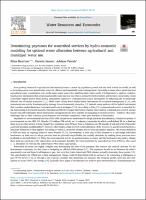Mostrar el registro sencillo del ítem
Determining payments for watershed services by hydro-economic modeling for optimal water allocation between agricultural and municipal water use
| dc.contributor.author | Haavisto, R. | |
| dc.contributor.author | Santos, Darwin | |
| dc.contributor.author | Perrels, A. | |
| dc.date.accessioned | 2019-07-07T17:26:37Z | |
| dc.date.available | 2019-07-07T17:26:37Z | |
| dc.date.issued | 2019-04 | |
| dc.identifier.citation | Haavisto, R., Santos, D., & Perrels, A. (2019). Determining payments for watershed services by hydro-economic modeling for optimal water allocation between agricultural and municipal water use. Water Resources and Economics, 26. https://doi.org/10.1016/j.wre.2018.08.003 | es_PE |
| dc.identifier.uri | https://hdl.handle.net/20.500.12542/40 | |
| dc.description.abstract | Evergrowingdemandforagriculturalandmunicipalwater,causedbypopulationgrowthandtheneedtofeedtheworld,aswellasincreasingstressoverwaterbodiescraveforefficientandsustainablewatermanagement.Especiallyinareaswheremunicipalandagriculturalwaterconsumptionrelyonthesamewatersourcesforsatisfyingtheirwaterneeds,itisimportanttoexploreevidence-basedpolicyinstrumentsthatachievesustainablewateruseinawaythatisoptimalforbothdwellersandfarmersconcurrently.Someeconomists regard market-based policy instruments superior to command-and-control instruments in enhancing the economicallyefficient use of natural resources [1,2]. While some clearly favor market-based instruments in ecosystem management [3,4], suchinstrumentsarenotthedominantpolicystrategyforenvironmentalprotection[5].Instead,manyauthorscallforhybridinstrumentsthatcombinemarket-basedandcommand-and-controlstrategies[5,6].AccordingtoVatn[7],command-and-controlisessentialforthefunctioningofecosystemmarkets.MuradianandRival[5]arguethathybridregimesthatcombinecommand-and-control,marketbasedtoolsandcommunity-basedinstitutionalarrangementsaremoresuitableinmanagingecosystemservices—whichsooftenraisechallengesduetotheircommongoodcharacterandintrinsiccomplexity—thanpuremarketsorhierarchies. | en_US |
| dc.language.iso | eng | en_US |
| dc.publisher | Elsevier B.V. | en_US |
| dc.relation.ispartof | urn:issn:2212-4284 | |
| dc.rights | info:eu-repo/semantics/openAccess | es_PE |
| dc.rights | Attribution-NonCommercial-ShareAlike 3.0 United States | * |
| dc.rights.uri | http://creativecommons.org/licenses/by-nc-sa/3.0/us/ | * |
| dc.source | Servicio Nacional de Meteorología e Hidrología del Perú | es_PE |
| dc.source | Repositorio Institucional - SENAMHI | es_PE |
| dc.subject | Social Sciences | en_US |
| dc.subject | Environmental Science | en_US |
| dc.subject | Ecosystem service | en_US |
| dc.subject | Conservation | en_US |
| dc.subject | PES schemes | en_US |
| dc.subject | Modeling | es_PE |
| dc.subject | Resource allocation | es_PE |
| dc.subject | Water economics | es_PE |
| dc.subject | Water use | es_PE |
| dc.subject | Watershed | es_PE |
| dc.title | Determining payments for watershed services by hydro-economic modeling for optimal water allocation between agricultural and municipal water use | en_US |
| dc.type | info:eu-repo/semantics/article | en_US |
| dc.identifier.isni | 0000 0001 0746 0446 | |
| dc.description.peerreview | Por pares | |
| dc.identifier.doi | https://doi.org/10.1016/j.wre.2018.08.003 | |
| dc.source.volume | 26 | es_PE |
| dc.source.issue | 100127 | es_PE |
| dc.source.initialpage | 1 | es_PE |
| dc.source.endpage | 17 | es_PE |
| dc.source.journal | Water Resources and Economics | es_PE |
| dc.subject.sinia | consumo de agua para regadio - Agua | |
| dc.type.sinia | text/publicacion cientifica | |
| dc.identifier.url | https://hdl.handle.net/20.500.12542/40 |
Ficheros en el ítem
Este ítem aparece en la(s) siguiente(s) colección(es)
-
Artículo científico [171]









